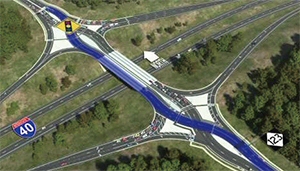An Assessment of Safety and Geometric Design Criteria for Diverging Diamond Interchanges
NCSU has recently invested in a FORUM8 Driving Simulator along with VR-Design Studio DS (formerly UC-win/Road DS) as part of this Transport Research Board funded project. The aim of the project is to investigate certain features of driver behaviour when confronted by a Diverging Diamond Interchange.
Chris Cunningham, the Director of the Highway Systems Group at the Institute
for Transportation Research and Education at NCSU commented "We are
going to use the FORUM8 driving simulator to look at various unique geometric
design components of these Diverging Diamond Interchanges, such as the
crossover design and the right and left turn movements at the off ramp,
we believe that this is where drivers must look down an approach which
may not be intuitive."
The use of Diverging Diamond Interchanges (DDI), also referred to as Double Crossover Diamonds (DCD), has become more prevalent throughout the United States over the past 3 to 5 years.
Overall, DDIs are gaining momentum within the interchange design community. However, only a limited amount of guidance on the design of these types of interchanges exists.
The first DDI in the US was constructed in 2009 by the Missouri Department of Transportation (MoDOT). The DDI design accommodates left-turning movements at signalized, grade-separated interchanges of arterials and limited-access highways, while eliminating the need for left-turn phasing. On the arterial, two-phase traffic signals are installed at the ramp terminal intersections to shift traffic over to the left side of the roadway between the nodes of the interchange.
Once on the left side of the arterial roadway, vehicles can turn left onto limited-access ramps without stopping and without conflicting with through traffic.
Currently, there are no existing guidelines/standards for design of this type of interchange.
The design is extremely dependent on site-specific conditions which are demonstrated by the variations in the design elements of the DDIs constructed to date.
Additionally, there is relatively little accident history available as no DDIs existed in North America prior to 2009.
Analysis of the actual safety and operational performance of DDIs has been limited to a handful of in-service DDIs.
An assessment of the current design process and safety analysis is needed to ensure that recent advances and emerging issues are appropriately leveraged and/or reflected in design practices, guidelines, and policies.
The research objective is to identify, review, and evaluate the geometric design features and the associated safety and operational performance of in-service DDIs across the US.
This information will then be utilized to develop recommendations for the AASHTO Technical Committee on Geometric Design for consideration as future geometric policy and guidelines.
Two basic questions will be addressed: (1) What are the essential design characteristics of a DDI and how should an engineer utilize this information in the design of a DDI and
(2) What are the safety and operational benefits of utilizing a DDI and how might the designer utilize this information in their design?
Revision content of UC-win/Road Ver. 11 such as the enhancement of rendering
engine, function to display point clouds generated via SfM analysis of
digital camera photo data in VR space, and loading of OpenStreetMap are
very useful for this research in terms of being able to modelize DDI geometry
design in 3DVR more real, faster, and with higher precision
In next version 12, features for research driving simulator including simulation
timer control are planned to be enhanced, with a policy to promote software
and system development related to autonomous driving R&D, and ADAS
that is attracting attentions in the automobile field. While year 2016
is expected to be the first chapter of the era of VR, FORUM8 keeps providing
UC-win/Road that has equipped with advanced new features in order to realize
"the era of Virtual Reality". This promotes road design verification,
vehicle system development, ITS traffic system research, interaction research
between driver, vehicle, road, and traffic by utilizing driving simulator's
diagnosis function in Europe.


